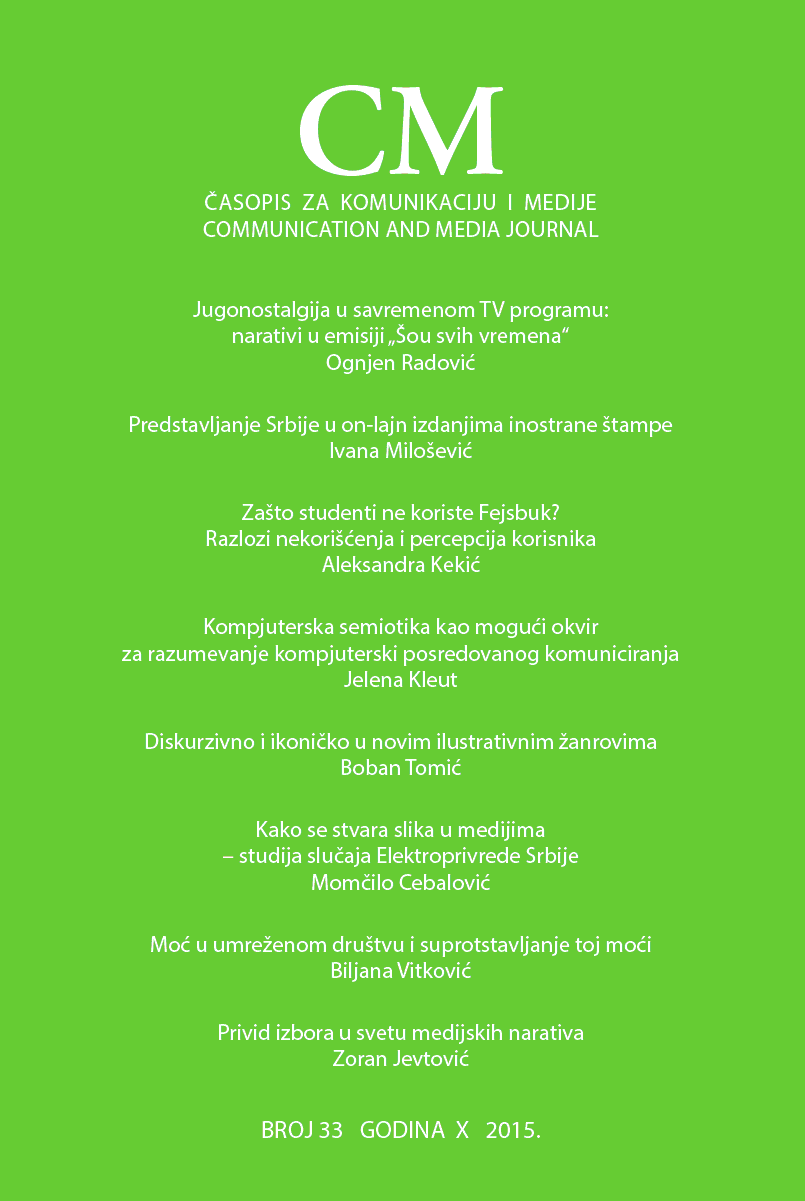Yugo-nostalgia in modern television: Narratives in the show "Šou svih vremena"
Abstract
After the breakup of Yugoslavia, Yugo-nostalgia is present in the television content primarily in entertainment and informative content (series, movies and news). One of the newest examples of invoking the past and metanarratives connected to Yugoslavia is the variety show “The show of all times” that was aired on RTS (Radio Television of Serbia) and on the other televisions in the region. The paper tries to define the role of nostalgia and narrators and how it is represented the time of Yugoslavia.
Second and third level narrators (all except the all-seeing author) are defined as catalysts of Yugo-nostalgia, as those who represent the link between the audience and the time of brotherhood and unity, as moderators (hosts) and as authors-creators of all the narratives in the show and its’ parts (all-seeing authors and the host Nikola Kojo). In fact, they have been used for the purpose of resuscitation and rehabilitation of the narratives of the former Yugoslavia in the present through collective nostalgia. The elements of the metanarrative about former Yugoslavia used in the show are – the free country, a country of brotherhood and unity, the golden age, the time of peace and security, the time of real moral values, the age of innocence, the good old days and the land of plenty. All these elements are describing past time through the spectacle (songs, dance and quiz), humor (sketches, interviews and quiz) and the collective memories of life and popular culture of the former Yugoslavia, positively interpreted and re-positioned the then relations and values.
References
Albvaš, M. (1999). Kolektivno i istorijsko pamćenje. Reč – časopis za književnost, kulturu i društvena pitanja. 56, 63–83.
Albanese, N. (2012). A Postmodern Sense of Nostalgia. Pell Scholars and Senior Theses. Paper 81. Posjećeno 10. 3. 2014. URL: http://digitalcommons.salve.edu/pell_theses/81
Bal, M. (1999). Narratology Introduction to the Theory of Narrative (2nd ed). Toronto: University of Toronto Press Inc.
Bajić-Simeunović N. (2012). Jugonostalgija kao istraživački koncept istorije komuniciranja: moguće perspektive istraživanja. Etnoantropološki problemi. 7(1): 127–141.
Barthes, R. (1975). S/Z: An Essay. New York: Hill and Wang.
Boym, S. (2007). Nostalgia and its Discontents. The Hedgehog Review, 9(2): 7–18. Posjećeno 05.03.2014. URL: http://www.iasc-culture.org/eNews/2007_10/9.2CBoym.pdf.
Davis, F. (1979). A Sociology of Nostalgia. London: The Free Press.
Casey, E. (1987). The World of Nostalgia. Man and World, 20: 361–384.
Cook, P. (2005). Screening the Past: Memory and Nostalgia in Cinema. London: Routledge.
Fisk, Dž. (2001). Popularna kultura. Beograd: Clio.
Genette, G. (1983). Narrative Discourse – An Essey in Method. New York: Cornell University Press.
Herman, L. & Vervaeck, B. (2005). Handbook of Narrative Analysis. Lincoln - London: University of Nebraska Press.
Holdsworth, A. (2011). Television, Memory and Nostalgia. Houndmills: Palgrave Macmillan.
Jameson, F. (1991). Postmodernism, Or, The Cultural Logic of Late Capitalism. Durham: Duke University Press.
Jupp, V. (2006). The SAGE Dictionary od Social Research Methods. London: Sage Publications Ltd.
Kuljić, T. (2010). Sećanje na titoizam: hegemoni okvir. Filozofija i društvo. 2/2010: 225–250.
Kuljić, T. (2003). Tito u novom srpskom poretku sećanja. Sociologija. XLV (2): 97–116.
Palmberger, M. (2008). Nostalgia matters: Nostalgia for Yugoslavia as potential vision for a better future. Sociologija. L(4): 355–370.
Spasić, I. (2012). Jugoslavija kao mesto normalnog života: Sećanja običnih ljudi u Srbiji. Sociologija, LIV(4): 577–594.
Velikonja, M. (2008). Titostalgia – A Study of Nostalgia for Josip Broz. Ljubljana: Mediawatch, Peace Institute.
Wildschut, T., Sedikides, C. & Arndt, J. (2006). Nostalgia: Content, Triggers, Functions. Journal od Personality and Social Psychology, 91(5): 975–993.
Williams, K. (2003). Understanding Media Theory. New York: Arnold Publishers
Wood, D. ur. (2003). On Paul Ricoeur – Narrative and Interpretation. London and New York: Routledge.
Copyright
Authors retain copyright of the published papers and grant to the publisher the non-exclusive right to publish the article, to be cited as its original publisher in case of reuse, and to distribute it in all forms and media.
Licensing
The published articles will be distributed under the Creative Commons Attribution ShareAlike 4.0 International license (CC BY-SA). It is allowed to copy and redistribute the material in any medium or format, and remix, transform, and build upon it for any purpose, even commercially, as long as appropriate credit is given to the original author(s), a link to the license is provided, it is indicated if changes were made and the new work is distributed under the same license as the original.
Users are required to provide full bibliographic description of the original publication (authors, article title, journal title, volume, issue, pages), as well as its DOI code. In electronic publishing, users are also required to link the content with both the original article published in CM: Communication and Media and the licence used.
Authors are able to enter into separate, additional contractual arrangements for the non-exclusive distribution of the journal's published version of the work (e.g., post it to an institutional repository or publish it in a book), with an acknowledgement of its initial publication in this journal.
Self-archiving policy
Authors are permitted to deposit author’s publisher's version (PDF) of their work in an institutional repository, subject-based repository, author's personal website (including social networking sites, such as ResearchGate, Academia.edu, etc.), at any time after publication.
Full bibliographic information (authors, article title, journal title, volume, issue, pages) about the original publication must be provided and links must be made to the article's DOI and the license.
Disclaimer
The views expressed in the published works do not express the views of the Editors and the Editorial Staff. The authors take legal and moral responsibility for the ideas expressed in the articles. Publisher shall have no liability in the event of issuance of any claims for damages. The Publisher will not be held legally responsible should there be any claims for compensation.

